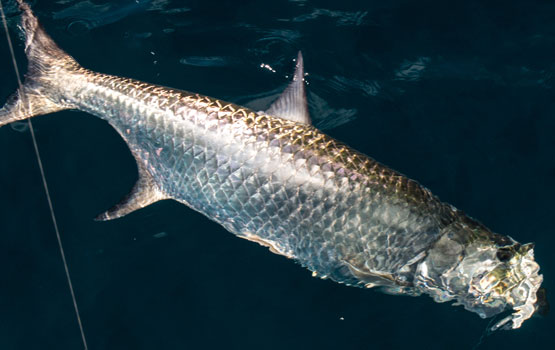
Scientists are trying to determine if tarpon are breeding in the Pacific.
Courtesy FECOP
Twenty-seven years ago, Didiher Chacon was a young biologist from the National University in Costa Rica. Todd Staley, co-creator of 12 Fathom Jigs that forever changed tarpon fishing in Boca Grande, Florida, in the late 1980s, had just moved to Costa Rica to manage Archie Fields’ Rio Colorado Lodge, a world-famous tarpon destination. Chacon stopped by the lodge one day to explain he was collecting tarpon samples for analysis by Dr. Roy Crabtree in Florida. Staley, who was familiar with Crabtree’s work, jumped at the chance to catch a few tarpon and help science at the same time.
Chacon went on to become well respected in marine conservation circles. He is currently the director of the NGO, Latin American Sea Turtles, as well as a professor at the National University in the post-degree program. Staley moved to the Pacific side of Costa Rica after Archie Fields died and for two decades managed famous billfish destinations like Golfito Sailfish Ranch and Crocodile Bay. He began working full time for FECOP, a Costa Rica sport fishing advocacy and conservation group, last May.
“I first saw a tarpon roll in the Pacific back in 1995,” Staley explains. “For a minute I thought I was losing my mind but then I thought, I have seen tarpon roll my whole life, I know one when I see one.” Eventually one of the charter captains returned to the dock one day with a 40-pound tarpon and had no idea what it was. Since then clients have hooked five to 10 tarpon a year, occasionally landing and releasing a few. The largest tarpon taken was estimated around 130 pounds. It has always been assumed that the tarpon, which are not indigenous to Pacific waters, passed through the Panama Canal and took up residence on the Pacific coast.
The puzzle got even more interesting when Saul Porras caught a baby tarpon while snook fishing at the mouth of a creek on the Osa Peninsula in southern Costa Rica. Chances that little guy passed through the canal and swam that far are extremely slim. So, are tarpon now breeding in the Pacific? They have been caught all along the Pacific coast of Costa Rica, especially in the southern zone. An increasing number have been taken in the Sierpe and Coto Rivers. Tarpon have also been have recorded as far south as Colombia and as far north as El Salvador.

Most of the river tarpon are small, but some as large as 100 pounds have also been captured.
Courtesy FECOP
FECOP agreed to sponsor a project to find out more about tarpon in the Pacific. Staley contacted Chacon (the two had remained friends over the years) and he agreed to work on the science part of the project. “The Sierpe Wetlands are per-fect habitat for juvenile tarpon,” Chacon says. “That very well may account for the increase in numbers of tarpon caught there in the last few years.” Most of the river tarpon are small, less than 30 pounds, but some as large as 100 pounds have also been captured.
Tropical Storm Nate delayed the project when massive amounts of rain fell, which not only caused major landslides but also completely flushed everything out many of the coastal rivers.
Phase 1 of the project will concentrate in southern Costa Rica. A DNA comparison will be done between Pacific-caught tarpon and tarpon taken at various locations on the Caribbean side of the country. Biologists will also study what the Pacific tarpon have been feeding on. This can be accomplished with a small tissue sample without sacrificing the fish. All Pacific-caught tarpon will also be tagged.
Chacon notes that there is a possibility tarpon could change the ecology of the rivers over time. So far it is not yet known what these tarpon are feeding on or how they will affect native fish. But the ever-increasing encounters along Costa Rica’s Pacific coast make it worth finding out.
Costa Rica fishing lodges shouldn’t rush to put this fish in their brochures quite yet, but still a very interesting phenomenon! Check back for more information about tarpon and costa rica fishing at www.fecop.org
For more information contact: www.fishcostarica.org or info@fecop.org.























1 Comment
This is very exciting news! I have thought about retiring in Costa Rica and I love to catch small tarpon.
What is near the Sierpe wetlands?